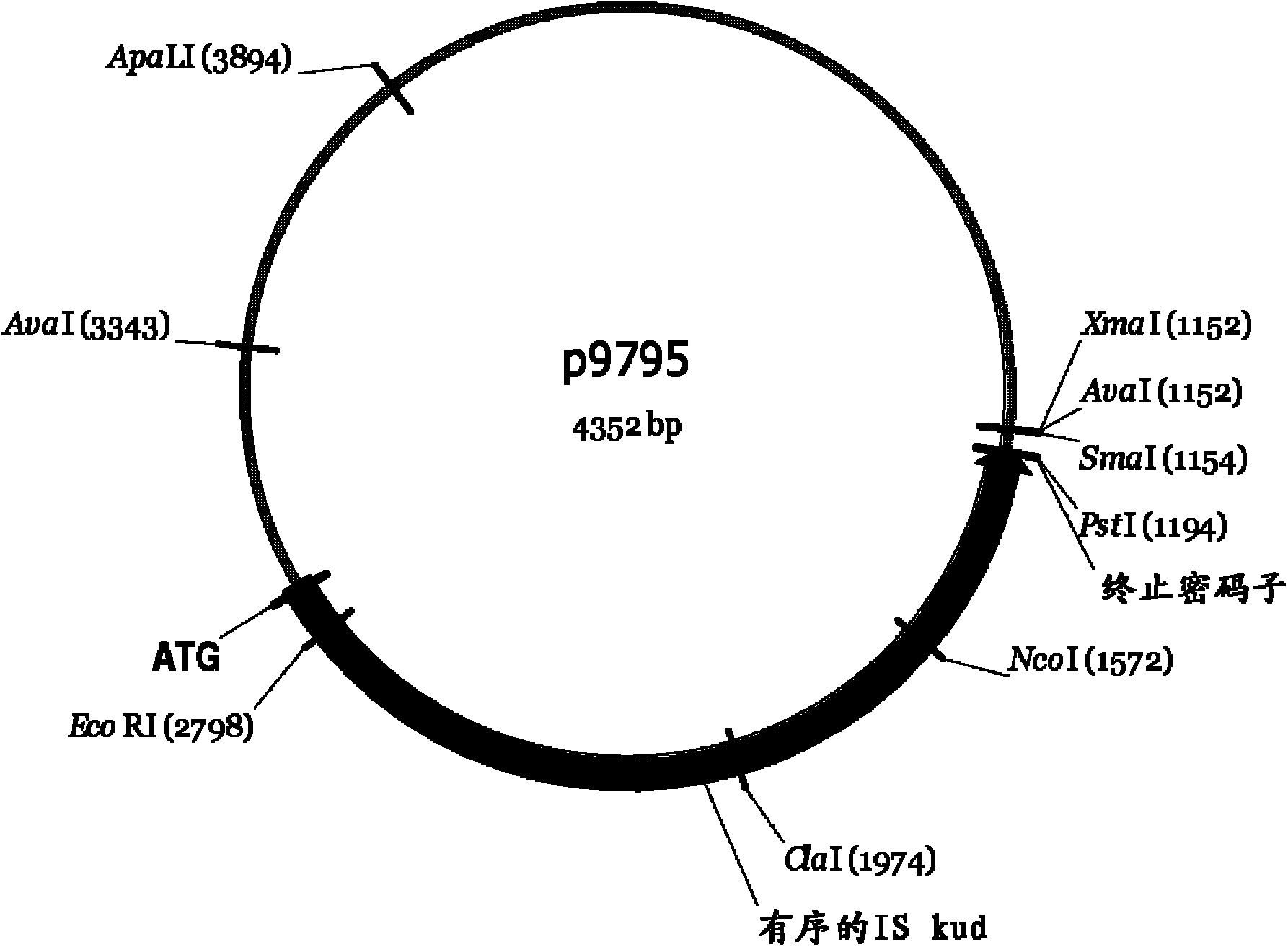Three-dimensional structure of isoprene synthase and its use thereof for generating variants
An isoprene synthase, three-dimensional structure technology, applied in the directions of enzymes, lyases, carbon-oxygen lyases, etc., can solve the problems of difficulty in obtaining polypeptide crystals and easy crystallization of polypeptides.
- Summary
- Abstract
- Description
- Claims
- Application Information
AI Technical Summary
Problems solved by technology
Method used
Image
Examples
Embodiment 1
[0312] Embodiment 1. Construction of MBD kudzu IspS
[0313] This example describes the construction of a vector expressing a maltose binding protein-kudzu isoprene synthase fusion molecule.
[0314] I. Construction of pTrcKudzu
[0315] A synthetic gene encoding the isoprene synthase (IspS) of Pueraria lobata and codon-optimized for Escherichia coli was purchased from DNA2.0 (Menlo Park, CA) as plasmid p9795 ( figure 2 and 3) provide. The insert was removed by digestion with BspLU11I / PstI, gel purified and religated into NcoI / PstI-digested pTrcHis2B (Invitrogen, Carlsbad, California). The resulting plasmid was called pTrcKudzu ( Figure 4 and 5). The stop codon in the insert precedes the PstI site, resulting in a construct in which the His-tag is not attached to the IspS protein.
[0316] II. Construction of plasmid pMAL-C4X Kudzu
[0317] According to the manufacturer's instructions, using plasmid pTrcKudzu as DNA template, primers EL-959 and EL-960 of Table 1-1, 10 m...
Embodiment 2
[0324] Example 2. IspS variants used for crystal structure experiments
[0325] This example describes the generation of affinity-tagged isoprene synthase (IspS) enzymes for expression, purification and crystallization.
[0326] I. Strain Construction
[0327] For constructs in the pET200D-TOPO vector (Invitrogen), gel extraction and purification (Qiagen) from Populus alba, P. PCR product of Yang's IspS enzyme. The PCR reaction of the pET200 construct was as follows: The reaction mixture was: 1 μl (template)-pET24a-P.alba, 5 μl 10X PfuUltraII Fusion buffer, 1 μl dNTP (10 mM), 1 μl primer (50uM), primer F-(MCM219 or 218), 1 μl Primer (50uM) Primer R-(MCM182), 41μl diH 2 O and 1 μl of PfuUltra II Fusion DNA polymerase from Stratagene; cycling parameters were: 95°C for 1 min, 29 cycles of "95°C for 1 min, 55°C for 20 sec, 72°C for 27 sec", followed by 72°C for 3 min, Then at 4°C until cooling, using an Eppendorf Mastercycler. Similar responses were performed for aspen, populus...
Embodiment 3
[0372] Three-dimensional structure of embodiment 3.IspS
[0373] Seven constructs of plant isoprene synthase (IspS) were prepared, and it was hoped that one or more would yield crystals suitable for x-ray diffraction. These constructs are: a construct containing N-terminal histidine-tagged maltose-binding protein and kudzu IspS (MBP-kudzu); a construct containing N-terminal histidine-tagged full-length P. alba IspS (MD08-99 ); remove the first 19 residues of P. alba IspS (MD08-100) at the N-terminus, and the construct will also remove the histidine tag after purification; full-length untagged P. alba IspS ( Strain RM11608-2); a truncated P. alba IspS construct characterized by two additional residues (MD09-167) preceding the generation of the double arginine motif; a P. americana IspS was produced comprising N-terminal histidine tag and N-terminal truncation (MD08-104); another construct consisting of IspS from P. japonicus with N-terminal histidine tag and N-terminal truncat...
PUM
| Property | Measurement | Unit |
|---|---|---|
| thickness | aaaaa | aaaaa |
Abstract
Description
Claims
Application Information
 Login to View More
Login to View More - R&D
- Intellectual Property
- Life Sciences
- Materials
- Tech Scout
- Unparalleled Data Quality
- Higher Quality Content
- 60% Fewer Hallucinations
Browse by: Latest US Patents, China's latest patents, Technical Efficacy Thesaurus, Application Domain, Technology Topic, Popular Technical Reports.
© 2025 PatSnap. All rights reserved.Legal|Privacy policy|Modern Slavery Act Transparency Statement|Sitemap|About US| Contact US: help@patsnap.com



